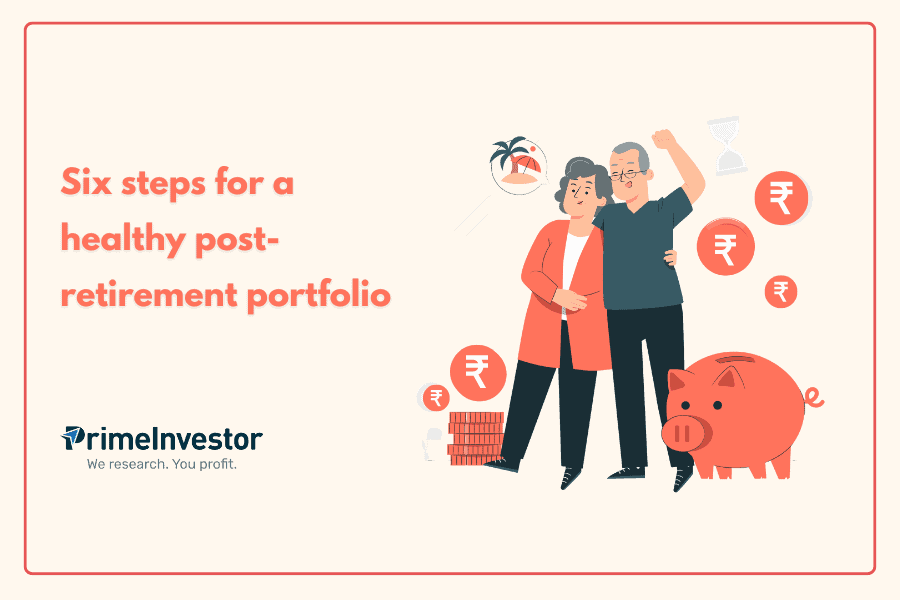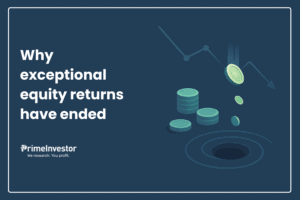It takes a lot of scrimping, saving and investing to build a retirement corpus. But once you have built it and have just retired, how should your portfolio now look to tackle retirement? In this article we detail six steps to building a bullet-proof post-retirement portfolio.

# 1 Assess the required corpus
The first step is to clearly assess whether the retirement corpus you have accumulated is large enough to fund your retirement. The size of corpus you need is decided by many moving parts – inflation during your retired years, equity and debt market behaviour, your portfolio returns, taxation of those returns and your own longevity after retirement.
For illustration, let’s assume that your expenses at age 60 are Rs 1 lakh per month and they inflate at 6% for each year of your retired life. If the post-tax returns on your portfolio exactly match inflation and you live until 85, you will need a corpus of Rs 2.95 crore to fund your retired life from 60 to 85. This is about 25 times your annual expenses (Rs 12 lakh) at 60. If your longevity is stretched to 90 years, then the corpus you will need shoots up to Rs 3.53 crore or 29 times your annual expenses.
If your post-tax returns after retirement are 5 % p.a and not 6%, you will need a corpus of Rs 4.1 crore or 34 times your annual expenses. You can use our retirement calculator to plug in your own numbers and arrive at the required corpus.
But overall, calculations suggest that when you retire at 60, you will need a corpus that covers your current annual expenses by between 25 and 34 times to see your through your remaining years. As you have no control over your longevity or inflation, the only variable you can control is the returns you earn, which is contingent on your asset allocation.
As a broad rule – if you have accumulated just 25 times or less by the time you are 60, you will need to adopt a riskier asset allocation to manage your post-retirement expenses. If you have accumulated 30 times or more, you can afford a conservative asset allocation.
# 2 Capitalise on sovereign instruments
After retirement, recouping any capital loss becomes doubly difficult because there is no new income to refill your portfolio. Therefore, it is important to prioritise capital safety on as much of your corpus as you can afford, when choosing investments. Sovereign debt instruments which offer the most capital safety will not offer high returns. Therefore, this is a careful trade-off.
Thankfully, in India, there are sovereign-backed schemes that offer higher-than-market interest rates.
Your first move on retiring should be build the foundations of your income portfolio with these schemes. The first one is the post office Senior Citizens Savings Scheme, which offers fixed returns for 5 years, with the option to renew the deposit indefinitely thereafter. This scheme offers a spread of 100 basis points or more over the prevailing market yield on 5-year government bonds. It pays out interest quarterly and is backed by the Government of India. Interest rates are announced at the beginning of every quarter and investors can lock into prevailing rates for 5 years. The current interest rate on SCSS is 8.2%.
This is taxable at your slab rate. Apart from a healthy spread over g-secs and bank FDs, a big plus of SCSS is its decent liquidity. The scheme allows premature exit. Exits within one year will lead to forfeiture of interest and exit after 1 year entails a 1.5 per cent penalty, but the ability to withdraw your money in emergencies is a big plus in retirement.
The maximum investment allowed in this scheme per individual is Rs 30 lakh. Retirees should use SCSS as the bedrock of their income portfolio. At current rates of 8.2%, the scheme can straight away deliver upto Rs 2.46 lakh of annual pre-tax income.
For retirees with large corpuses though, it may not be sufficient to ensure capital safety on just Rs 30 lakh. A second scheme for them to explore is GOI Floating Rate Bonds, sold through the RBI Retail Direct platform and banks. These sovereign-backed bonds with 7-year lock-in, offer floating interest rates which are reset on a half-yearly basis.
While floating rates do expose the holder to the risk of rate swings, the interest rates on these bonds are set at a 35 basis point spread over the 5-year NSC. The 5-year NSC in turn offers a 30-40 basis points spread over 5-year g-secs. This results in this scheme usually paying out higher income than other high-safety instruments. Though NSC rates are subject to quarterly reset, the government has not actually reduced rates on NSC very sharply during past rate declines, as it is a small savings scheme.
In FY21, when the repo rate fell to 4% due to Covid and banks slashed their FD rates to 5.5%, the NSC rate was retained at 6.8%. It has since risen to 7.7%. The GOI Floating Rate Bond offers 8.05% annual interest currently. Even in the event of a rate cut, its rate is likely to remain above comparable g-secs or FDs from leading banks.
There is no upper limit on individual investments in GOI Floating Rate Bonds. However, the lack of liquidity on this bond (it is not listed or traded) before the 7-year maturity is a minus. So are the floating rates, which make for fluctuating income.
While these two sovereign-backed bonds offer 100% safety with decent returns, they will not beat inflation on a post-tax basis. Retirees should therefore allocate to them in such a way that they generate the minimum level of monthly income required to meet basic living expenses. The rest of your debt portfolio needs to be actively managed to beat inflation on a post-tax basis.
# 3 Follow an active debt strategy
To generate comfortable levels of income after retirement, you need to supplement the above sovereign-backed instruments with higher yield fixed income options.
Earning a higher yield from debt instruments usually entails taking on higher risk. But rather than take on credit risk by investing large sums in corporate FDs, risky state government entities (such as TNPFC/ UPPFC) or lower rated NBFCs, you can use active duration strategies to bump up your debt returns.
This calls for an active debt strategy where you time the rate cycle. Interest rate cycles in India typically play out every 4-5 years. In a falling cycle, repo rates can sink to sub-5% levels and in a rising cycle, they can go as high as 7.5-8%. Interest rates on longer tenor gilts and corporate bonds are obviously much higher. Being aware of this and locking into long tenor FDs/bonds/debt mutual funds when a rate cycle is peaking, helps you enjoy healthy real returns when rates fall.
For instance, FD rates for leading banks ruled at over 8.25% in FY15, fell to 6.25% by FY17, rose again to 7% levels in FY19, fell again to sub 6% during Covid and are now back at about 6.75%. Therefore, seniors who locked into 5-year SBI FDs in FY18 at 7.2% could have side-stepped the worst of the Covid downcycle when FD rates sank below 5.5%. Seniors who locked into 3-year Sundaram Finance FDs at 8.25% in FY19, would have enjoyed high real returns during Covid. Locking into FDs from AAA rated NBFCs for long tenors when rates are high, can help you earn a very healthy real return across a rate cycle.
An active debt strategy may sound tough, but we make it easy for you at Primeinvestor. We keep close track of the rate cycle and periodically publish outlooks on rates. We also recommend actions that you must take to make the most of prevailing rates. You can track our regular debt updates here.
Our latest article on why this is the right time to lock into 4 to 5-year NBFC FDs is here. Retirees today have an opportunity to tide over a falling cycle by locking into high-return long-tenor FDs.
# 4 Debt MFs: Liquidity with returns
If setting up regular income and keeping one step ahead of inflation are two key challenges during retirement, investors often ignore the third one. This is ensuring that your portfolio is more liquid and monetizable now, than it was when you were working. The lack of income during retirement makes liquidity a key attribute to keep in mind when making your asset choices.
Financial assets are clearly more liquid than physical assets such as real estate. Real estate, however valuable, can be almost impossible to dispose off in an emergency. During crises like Covid, transactions in real estate completely froze. But it is important to note that even within financial assets, some assets are more liquid than others. Open-end debt mutual funds, which offer you anytime redemption, are more liquid than GOI Floating Rate Bonds or FDs where premature liquidity entails a haircut.
Apart from liquidity, debt MFs offer you the opportunity to compound your returns to build wealth and earn capital gains when rates fall. Timing the rate cycle and locking into long-tenor debt when rates are at a high can get you to even a double-digit return with gilt funds, constant maturity funds and some corporate bond categories.
Our rolling returns tool highlights that there have been 5-year periods where gilt funds have managed a 10% plus CAGR and banking/PSU and credit funds have gotten to a near 9% CAGR. Getting to these returns however calls for active tracking of the rate cycle. We at Primeinvestor do this to offer tactical calls on debt MFs. Do read our recent tactical call on corporate bond funds.
A combination of sovereign instruments, high yield FDs and debt MFs should make up the debt portion of your post-retirement portfolio.
# 5 Equity allocation for wealth creation
Many folks believe that they should give equities a wide berth after retirement because of stock market volatility. But retirees often do need an equity allocation to meet the following objectives.
- Equities help expand your corpus post-retirement, mitigating the risk of retirees running out of capital too early.
- An equity allocation can help increase your income over time and expand net worth so that you have room for luxuries in the latter part of your retired life
- It can help you leave behind a legacy for your loved ones
The main challenge in adding equity to your post-retirement portfolio is the fluctuations it is bound to cause in your net worth. The more equity you add to your allocation the higher, obviously, will be its long-term return potential.
But given that you will need constant monthly withdrawals from your portfolio to meet your expenses after retirement, large drawdowns due to equity market swings can be worrying and counter-productive. Maintaining a constant withdrawal rate in a deep correction will dent your capital and prevent a bounce-back in your net worth when stock markets rebound. We discussed this dilemma in this recent article explaining why balanced advantage funds may not work as good income vehicles.
However, this risk can be managed through judicious asset allocation. Should your post-retirement portfolio feature a 10%, 20%, 30% or higher equity allocation? We did a lot of number-crunching to find an answer to this existential question last year. We wrote a series of articles on asset allocation, which you can refer to here.
We concluded that a 20% or 30% equity allocation can get you to a 9-11% average annual return while containing the draw-down even in the worst years to 8-14% of your portfolio. Replacing some of your equity allocation with gold can further reduce draw-downs and smooth out your returns. This is a strategy retirees can follow.
You can use our proprietary allocation tool from this analysis, to work out your ideal allocation.
# 6 Minimise tax on returns
Finally, no amount of savvy planning and asset allocation can save your returns from the taxman. Therefore, what matters most in retirement is to maximise your post-tax return. Relying on instruments such as SCSS, GOI Floating rate bonds, NBFC FDs etc can shield one portion of your portfolio from the need for frequent rebalancing and the capital gains tax outgo that comes with it. On the debt MF/equity part, rebalancing is inevitable. But you can reduce its frequency by undertaking rebalancing only when the equity exposure overshoots your ideal allocation by say 5 percentage points or higher.
Besides this, rather than be too clever by half and attempt all sorts of tax-planning, a simple hack we suggest is to shift to the new tax regime. The new tax regime has the advantage of offering a complete tax rebate if your income is less than Rs 12 lakh per annum. It also offers wider slabs and lower rates if your income exceeds this threshold. Here’s our detailed argument for this switch
Now you can sit back and enjoy your retirement.





33 thoughts on “Six steps for a healthy post-retirement portfolio”
Can NPS Tier II be an option?
Yes but in that case you need to hold NPS Tier I as well. Tier It is not separately available
That’s correct. Underlying assumption – one should have Tier I.
Follow up Q, in that case the NPS Tier II is a better option?
Among the options, not necessarily a better option.
Hi Ma’am, to make things simpler, which ready-made portfolio can be used to implement the insights mentioned in this article? Thanks,
Unfortunately there isn’t a readymade portfolio yet.
.. a mistake. Please read my portfolio allocation as 25:70:05
another perspective – I am nearing 62 and I retired early i.e. about 7 years before. I feel, as ones grows older.. say age 62-63 onwards, the fooding habits changes to cope up with aging body. Eating-out reduces as it doesn’t suit now as it used to 5-10 year before. Nonveg or hard food or nuts intake & frequency reduces. Even traveling reduces. If you don’t keep a check/control on this, you tend to become sick and you will have to visit doctor and spend in medicine. You can’t eat samosa or burger between meals or mindless eating which was possible 10 years before. Fitness and simplicity becomes priority. What I want to say, is… year after year into retirement .. the reality is.. the yearly expenses reduces. It is not a simple mathematics or calculation. Finance planners exaggerate the amount needed. Yes, health premium and medicinal expenses will increase, emergency fund to meet medical issue is needed… but it will be much less than the proportional reduction in other expenses ( as I mentioned). In these 7 years I have travelled a lot … domestic as well as US, Australia, south Asia.. yet I have been able to maintain my corpus as it was 7 years before even now.. with 6% inflation. My corpus is not big.. its almost same as spoken in the article. equity : debt : gold allocation is 25:80:05 which does not perturb me in market corrections.
Thank you for sharing your experience sir. Worth pondering
Readers! A small correction in my comments… the portfolio allocation is 25:70:05
Comments are closed.